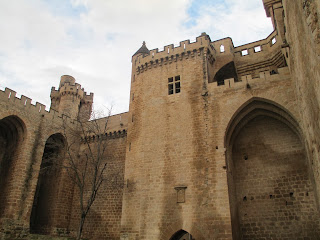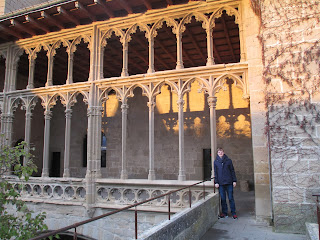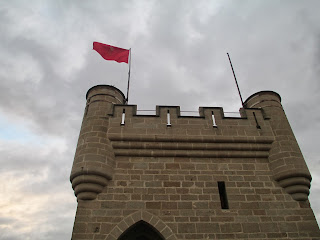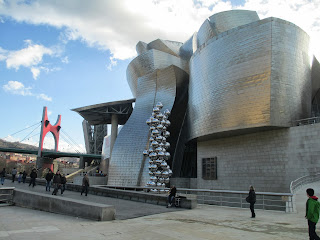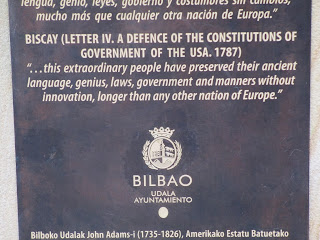Pamplona y el País Vasco
Pamplona and the Basque Country
Well everyone it's been awhile since I've posted. I hope you've all had a great Christmas! These last three days I took a trip to northern Spain to visit a friend named Jon who was on exchange at my highschool last year. He taught me an incredible amount of Spanish and especially prepared me for the linguistic differences which I was to experience in Spain. It was amazing to visit him after such a long time and aside from all that, I had an amazing trip! He lives in Pamplona, in autonomous community of Navarra (Navarre) and I went with him to the Basque Country. I will continue to explain all of this with the photos. I'm going to add some photos that are not my own solely to explain in a better way where I was and what I was doing, I will mark these with an asterisk (*). Disclaimer: the follow is an obnoxious amount of photos. (Click to enlarge)
Pamplona:
The first thing we visited was a fort built in the 16th century called La Ciudadela. I took photos but the view from above is much more impressive:
 |
| La Ciudadela, bird's eye view* |
 |
| The entrance, from across the street |
 |
| Inside |
 |
| A fairly large plaza in Pamplona, the statue represents the "Foral Laws" which are a special set of laws only applicable to Navarra. |
 |
| A better view |
 |
| A cool old church. You will be seeing a lot of those things in this blog post |
 |
| Saint Nicholas' Parish |
 |
| Mass was going on so I left quickly without taking pictures, this is from an online source* |
 |
| Big Christmas tree. You can also see my friend, Jon, making one of his many accidental appearances in the photos. |
 |
| Just a view to see the streets |
 |
| Street sign, in both Basque (Euskera) and Spanish |
Right now would be a good time to explain Basque. Basque, or Euskera, is a language spoken in the Basque Country, a small part of northern Spain and up into France. It is a linguistic phenomenon in the world as it is the oldest spoken language in all of Europe and no one knows where it comes from. It's been spoken in Spain longer than Spanish and has absolutely no relation to any language that we know of. As you can imagine, anyone who knows me well knows how amazing intriguing this whole deal is to me. The next day, we would cross into Basque Country proper where signs were written first in Basque and the in Spanish after. It was absolutely amazing.
 |
| A sculpture in a plaza representing the bull run. Jon shared with me that the man in the front left who's falling down is actually the sculptor. |
 |
| Bullfighting ring! |
 |
| A monument to Ernest Hemingway, who spent quite a long time living in Pamplona and used it's fiestas, in honour of San Fermin (the patron saint of the city and the reason they do the bull run), as the inspiration for his book, "The Sun Also Rises." |
 |
| The street to the side is also dedicated to him. |
 |
| More street views |
 |
| The cathedral |
 |
| The front, I would return here on Sunday for Latin mass. |
 |
| Cool side door. |
 |
| Some of the original city walls |
 |
| Pamplona's famous city hall |
 |
| Awesome coat of arms inside. |
 |
| Gate in a park |
 |
| The inscription on the gate |
We next went to the Royal Palace of Olite. It is a castle (yes, a real live castle!) in small town called Olite. The following is a bunch of photos from our explorations inside:
On the way we passed by a Roman aqueduct which was just jaw dropping to see, since we were in the car, I couldn't take a photo so here's a lame stock photo:
 |
| * |
 |
| A model of the whole thing |
 |
| Jon and his girlfriend, Flor. |
 |
| Views of the rooftops |
 |
| You'll see on the other side of the castle, on the tallest tower, the flag of the Kingdom of Navarra flown |
 |
| Stairs up the towers |
 |
| This egg looking thing was apparently the ice box for the lord who lived there. |
 |
| Stairs to the highest tower |
 |
| Me with the flag of Navarra |
 |
| Here's the flag of Navarra* |
 |
| Church from the 8th century that was unfortunately locked. |
 |
| The exterior |
 |
| Choir and band singing Christmas carols outside the church |
 |
| The country-side, those plants are all grape vines for making wine. |
The Basque Country, Bilbao:
One of the most famous buildings in Spain is the Guggenheim Museum. It's actually more of a work of art on the outside than the exhibits that are typically on the inside. Here are some photos of it:
 |
| * |
 |
| Having one of the north's famous "pinxtos" (small plate meals) before walking all the way around the mueseum. |
 |
| All of us with Jon's little brother, Iñaki, which is a Basque name that in Spanish is Ignacio and in English is Ignatius. |
 |
| Don't ask me, I have no idea, weird spider sculpture. |
 |
| Giant flower dog |
 |
| Museum's front |
 |
| Legal building |
 |
| View of the beautiful Basque flag. They are extremely proud of their Basque heritage and as a result display their flag almost everywhere. Some even want independence from Spain. |
 |
| The Basque flag* |
 |
| View of one of Bilbao's many bustling streets |
The following image was a weird one for me. We were walking on a random street, just minding our business when a statue catches my eye. I look straight at it and say "Adams!" It turns out there's a monument to John Adams in Bibao. I'll let you read what he plaque says:
 |
| Another cool legal building |
 |
| A close up, this is also one of the rare occasions that one will see a Spanish flag in the Basque Country. Did I mention their ambitions of independence? |
San Sebastián/Donostia (the second name is Basque):
 |
| The map |
In Donostia I got to see the Cantabrian Sea, that which is on the northern coast of Spain and the western of France. It is much colder and with much more rain and wind than the Mediterranean, much more to my liking!
 |
| Views of the bay |
 |
| City hall |
 |
| A really neat Sacred Heart of Jesus statue on the top of the hill |
 |
| More of the city |
 |
| The port |
 |
| The historic district |
 |
| Church of Saint Sebastian, martyr and patron of Donostia |
Unfortunately we were not able to enter the church so I don't have pictures of the interior.
 |
| This plaza used to be used for bull fights, it is the only bull fighting ring in Spain that is square shaped. |
 |
| The numbered seats |
 |
| More of the streets and people |
 |
| This is the Kursaal Conference Centre and Auditorium |
 |
| I have no idea what this is |
 |
| Me with my txapela, my Basque hat and my Ikurriña, the Basque flag |
 |
| I LOVE THE BASQUE COUNTRY! |
 |
| Leaving Donostia |
The Cathedral of Pamplona:
 |
| The front of the cathedral, constructed in the 14th century.* |
 |
| The interior* |
 |
| The side chapel of Saint Catherine of Alexandria, prepared for Latin mass |
 |
| Paradise |
 |
| These next few photos are photos of the side altars and chapels with relics of various saints. |
 |
| Where a knight is buried. |
 |
Main altar.
 |
 |
| Better view* |
 |
| Altar of San Fermin, the patron |
 |
| Relics of saints below |
 |
| Tombs of Carlos III and Leonor de Trastámara, king and queen of Navarra in the years from 1387-1425. |
 |
| Other side altars with relics |
 |
| The nave |
 |
| One more photo of Saint Catherine because this statue is really beautiful. |
I got to go check out the campus of the University of Navarra which is quite prestigious and famous throughout Europe. It's also where the famous Navarre Bible was published.
 |
| Old Templar church (locked during Winter) on the famous Camino de Santiago. |
We went next to a small town called Puente de la Reina where there is a Roman bridge:
 |
| The sign |
 |
| More of the city |
 |
| This is the door of just some random, normal person. Pretty sweet. |
 |
| Street views |
 |
| City hall, the sign says "Merry Christmas" in Spanish and Basque |
 |
| Another old church, the interior, altars and relics of Passionist blesseds. |
 |
| The relics |
 |
| The last day at the bus station! |
 |
| Sad departure but a great trip with one of my best friends, Jon. |
Thanks a ton for reading! I will be happy to answer any questions if you leave them in the comments. As always, I appreciate the support you give me by reading. If you ever get the chance GO TO THE BASQUE COUNTRY!
Pax & Bonum,
Sean





































































































